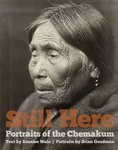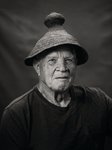“Still Here,” a photography exhibit ensuring the resilience of the Chemakum descendants through family portraits, was unveiled last week at Chimacum High School with a series of speeches …
This item is available in full to subscribers.
We have recently launched a new and improved website. To continue reading, you will need to either log into your subscriber account, or purchase a new subscription.
If you had an active account on our previous website, then you have an account here. Simply reset your password to regain access to your account.
If you did not have an account on our previous website, but are a current print subscriber, click here to set up your website account.
Otherwise, click here to view your options for subscribing.
* Having trouble? Call our circulation department at 360-385-2900, or email our support.
Please log in to continue |
|



“Still Here,” a photography exhibit ensuring the resilience of the Chemakum descendants through family portraits, was unveiled last week at Chimacum High School with a series of speeches from those involved.
The photo exhibit pushes against the belief that the Chemakum people were entirely wiped out in the mid-19th century for various causes, each speculative around the edges. The tribe is believed to be related to the Quilleutes of south Cape Flattery and once a tremendous power of the Sound.
Like many tribes, they were victims of expansionism, famine, and illness, however, the primary cause of near extinction is thought to be the result of a bloody conflict with the Suquamish Tribe around 1877.
The Chemakums did survive, however, and their descendants remain in the valley today.
The “Still Here” exhibit honoring those descendants was opened Thursday afternoon under a cover of muggy clouds that backlit the podium and the remarkable new canvases lining the high school’s transom windows.
The family portraits now preside over the student cafeteria, many of the members smiling or looking on stoically. The images, in dark, neutral tones are quietly powerful and give viewers an intimidating sense of breathing history.
Chimacum School District Superintendent Scott Mauk seemed to reference that feeling when he said the exhibit “plays this wonderful magic trick on us, where the artist and the art disappear and we enter into an infinite story. We become entwined with it.”
Mauk said it was a gift to host the exhibit, remarking that the project “braids us into the Chemakum descendant’s story and invites our curiosity and stillness… if we pay close attention to that experience, we cannot feel anything other than communion.
“I’m proud the [Chimacum] District was able to be part of this day… where we can be part of erasing the erasure of their people,” he added.
Chemakum Elder, Rosalee Walz, called the exhibit a “powerful testament” to her people and traditions and began her speech by saying, “I want you to know that our Chemakum family is grateful.”
The “Still Here” project began when someone asked Maria Mendes, chair of the Chimacum History Group, whether she knew that about a battle wherein the Chemakum were massacred, now extinct.
“I went, ‘Woah! No! The Chemakum are not extinct, they are here and they live among us,’” Mendes responded.
And so the seed was planted.
The group wanted to do something to establish Chemakum descendants’ presence today but Mendes was assertive in their strategy: “We can’t put anything up unless we involve the Chemakum people. It’s their story, not ours.”
Through continued efforts, connections were made and the project came alive.
Local photographer Brian Goodman was allowed attendance to the annual summer Chemakum gathering in HJ Carroll Park this past year to photograph the families.
He spoke gratefully at the event, expounding on Mauk’s sentiment by saying, “My hope is that 100 years from now people will see these images and not think about the photographer who captured them but be reminded that the Chemakum people are not disappeared. They’re still here.”
Goodman had help from Tim Lawson, Kerry Tremain, and Robert Tognoli. All four men are photographers with the League of Extraordinary Observers, a local coalition which aims to record the natural and social history of Jefferson County.
Goodman called the permission to photograph the families an honor.
Mendes’ co-chair of the Chimacum History Group and member of the Chinook Nation, Barbara Jo Blair, spoke as well, expressing similar gratitude: “I’m honored and humbled that you have trusted us enough with your stories to embark on this journey of healing and the story of justice.”
Blair went on to explain, “We hope that this exhibit sends a message to north Olympic Peninsula that the Chemakum peoples still inhabit their traditional lands, or return for the annual reunion every summer when they can... We’re hoping this is the beginning of the healing. And that the community will find other ways to connect with the families.”
The portraits will remain on display in the high school through the end of the year.
There will be another viewing from noon to 2 p.m. Saturday, May 28.
For more information contact Barbara Jo Blair at ncagquuf@gmail.com or go to www.leophoto.org/chemakum.